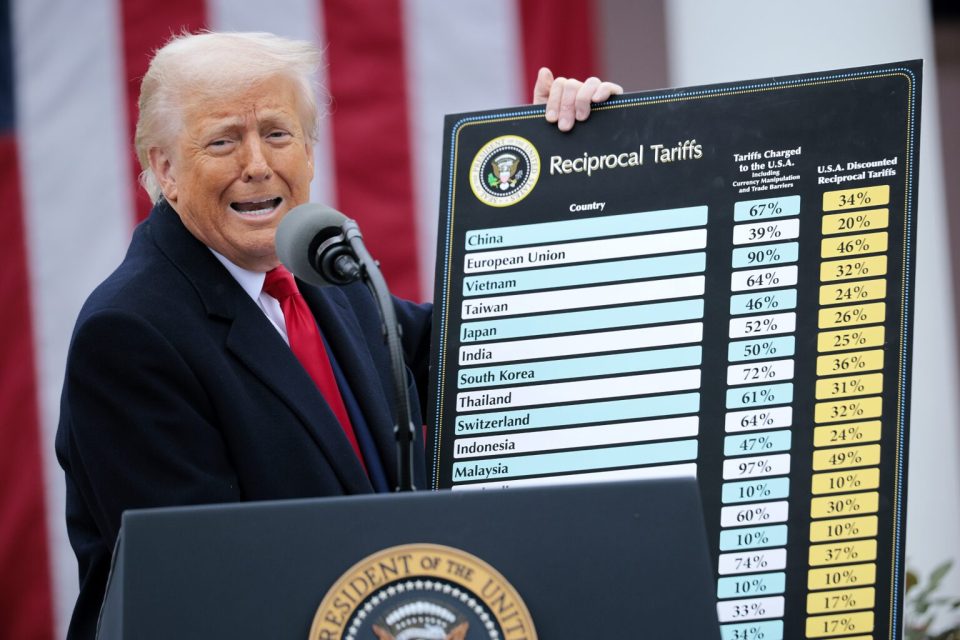U.S. stock futures nosedived on Thursday morning following President Donald Trump’s announcement of sweeping tariffs on nearly all U.S. trading partners. The move has rattled markets, raising fears of a global trade war and a potential recession.
The Dow Jones Industrial Average dropped by over 1,185 points, or approximately 3%, signaling a sharp decline at the market open. The S&P 500 fell 3.6%, while Nasdaq 100 futures plunged 4% as investors braced for widespread economic fallout from the tariffs.
The newly announced tariffs include a baseline 10% duty on imports from all nations, effective April 5, with significantly higher rates for specific countries deemed “bad actors.” For example, imports from China will face an additional 34% tariff, bringing the total rate to a staggering 54%. Other countries such as Japan and the European Union will also see elevated rates of 26% and 20%, respectively.
The White House justified the measures as an effort to address what it described as unfair trade practices, including existing tariffs and non-monetary barriers imposed on U.S. goods by foreign governments. However, these aggressive policies have sparked concerns about inflation, disrupted supply chains, and heightened risks to global economic stability.
The announcement triggered a selloff across sectors in premarket trading. Technology companies reliant on global supply chains were among the hardest hit. Apple (AAPL) shares dropped more than 7% in after-hours trading due to its heavy reliance on Chinese manufacturing. Other tech giants such as Microsoft (MSFT), Nvidia (NVDA), and Tesla (TSLA) also saw significant declines of 1%, 3.5%, and 4.1%, respectively.
Retailers with substantial exposure to imported goods faced even steeper losses. Dollar Tree (DLTR), Five Below (FIVE), and Gap (GPS) experienced premarket declines of up to 11%, reflecting investor concerns over increased costs that could squeeze profit margins.
Market experts expressed alarm over the potential long-term consequences of the tariffs. Adam Hetts, head of portfolio construction at Janus Henderson Investors, described the move as a “negotiation tactic” that could keep markets volatile for months. “The administration has shown an unexpectedly high tolerance for market distress,” Hetts noted, adding that the key question now is how much economic hardship policymakers are willing to endure during negotiations.
Jed Ellerbroek, a portfolio manager at Argent Capital, echoed similar concerns: “Trump is implementing an exceptionally aggressive tariff strategy, significantly more forceful than many investors imagined possible just six months ago.” He warned that these measures could exacerbate existing economic challenges, including persistent inflation and slowing growth.
The timing of these tariffs adds another layer of complexity to an already fragile economic environment. The U.S. economy has been grappling with rising interest rates and slowing consumer spending, while global markets have been dealing with geopolitical tensions and supply chain disruptions.
March saw the S&P 500 and Nasdaq Composite post their worst monthly losses since 2022 amid fears that new trade measures would reignite inflation and stall growth further. Analysts had hoped for a more measured approach from the administration but were caught off guard by the severity of the announced tariffs.
As markets prepare for what looks to be a tumultuous trading session, investors are left grappling with heightened uncertainty. With tariffs set to go into effect in just two days, companies reliant on global trade will likely face mounting pressure to adjust their operations or pass costs onto consumers. For now, Wall Street appears positioned for further volatility as it digests the implications of this aggressive trade policy shift.

